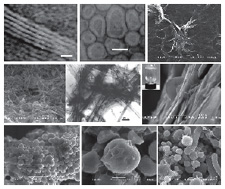|
|
Vol.
28 No. 2
March-April 2006
Supramolecular Assemblies With DNA (Special Topic Article)
Philippe Barthélémy, Stephen J. Lee, and Mark Grinstaff
Pure and Applied Chemistry
Vol. 77, No. 12, pp. 2133–2148 (2005)
doi:10.1351/pac200577122133
Information storage in chemical and biological systems involves
recognition processes occurring at the molecular and macromolecular
level. The implementation of a “code” can consist
of multiple noncovalent interactions that include hydrogen
bonds, π-stacking, hydrophobic interactions, and appropriate
molecular and supramolecular architectures.
 |
Examples of supramolecular assemblies formed
by nucleolipids. See PAC article for details.
Courtesy of P. Barthélémy, Université de Bordeaux, France. |
With
the double-helical DNA structure stabilized by Watson-Crick
hydrogen bond base-pairing and aryl π–π stacking
interactions, nature provides to scientists an example of
one of the most sophisticated supramolecular systems. Molecular
organization using these types of processes has become a very
powerful strategy for the construction of well-defined nanostructures.
Self assemblies using noncovalent interactions have been designed
to build fibers, membranes, two-dimensional monolayers, hydro,
and organo gels, for example.
This article highlights the research presented at the DNA
Supramolecular Assemblies workshop held in Avignon, France,
on 5–6 May 2004. It first focuses on the recent progress
achieved in the design of supramolecular self-assemblies that
mimic the molecular recognition functionalities found with
nucleic acids. It next presents several synthetic-DNA supramolecular
assemblies currently developed to transport nucleic acids
into cells. The marriage of supramolecular chemistry with
nucleic acids as illustrated through examples opens new avenues
for designing artificial molecular devices and expand the
current repertoire of supramolecular assemblies available.
www.iupac.org/publications/pac/2005/7712/7712x2133.html
Page
last modified 10 August 2006.
Copyright © 2003-2006 International Union of Pure and
Applied Chemistry.
Questions regarding the website, please contact [email protected]
|